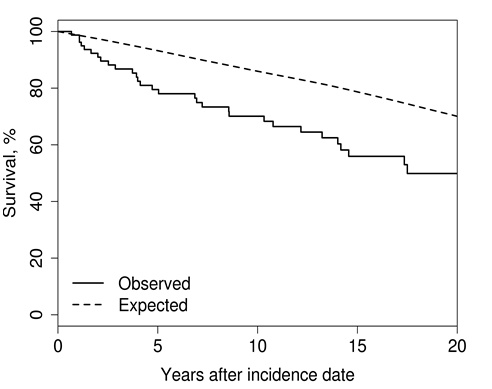Session Information
Date: Tuesday, October 23, 2018
Title: Systemic Sclerosis and Related Disorders – Clinical Poster III
Session Type: ACR Poster Session C
Session Time: 9:00AM-11:00AM
Background/Purpose: Systemic Sclerosis (SSc) is a complex and heterogenous chronic inflammatory disease characterized by widespread fibrosis of the skin and visceral organs, microvascular injury and evidence of immune system activation. We aimed to determine the incidence, prevalence and mortality of physician diagnosed SSc in a population-based cohort and to evaluate the performance of the ACR/EULAR 2013 Classification criteria vs. 1980 ACR criteria in classifying patients with SSc.
Methods: Medical records of patients with a diagnosis or suspicion of SSc in a geographically well-defined area from Jan 1, 1980 to Dec 31, 2016 were reviewed to identify incident cases of SSc (defined by physician diagnosis). Prevalent cases of SSc on Jan 1, 2015 were also identified. Incidence and prevalence rates were age and sex adjusted to the 2010 US white population. Survival rates were compared with expected rates in the general population. Fulfillment of the 1980 and 2013 classification criteria was ascertained.
Results: 79 incident cases of SSc (90% female, 87% Caucasians, mean age at diagnosis 55.8 +/- 16 y) from 1980-2016 and 49 prevalent cases on Jan 1, 2015 were identified. . The overall age- and sex-adjusted annual incidence for 1980-2016 was 2.7 (95% C.I. 2.1- 3.3) per 100,000 population (age-adjusted incidence was 4.6 (95% CI: 3.5-5.7) per 100,000 for females and 0.6 (95% CI: 0.2-1.1) per 100,000 for males), with no change in incidence over time. The age- and sex-adjusted prevalence on January 1, 2015 was 47.4 (95% CI: 34.1 -60.7) per 100,000 population. 64 of 79 (81%) patients fulfilled the 2013 classification criteria, while only 48% fulfilled the 1980 criteria. All but 1 patient that fulfilled the 1980 criteria also fulfilled the 2013 criteria. At SSc diagnosis, 74 (94%) patients had Raynaud’s, 13/44 (30%) had abnormal nail fold capillaries, 16/33 (48%) had digital ulcers/pitting scars, 43 (54%) had sclerodactyly, 39 (49%) had telangiectasias, 8 (10%) had pulmonary hypertension, and 7 (9%) had interstitial lung disease. 66 patients had limited cutaneous SSc, 11 had diffuse cutaneous SSc and only 2 had Sine scleroderma. 39 patients had a positive autoantibody for SSc : ACA in 29, anti Scl-70 in 8 and anti RNA-polymerase III in 2. Mortality among SSc patients was significantly higher in comparison to the general population (standardized mortality ratio, 2.24; 95% C.I., 1.52-3.18; Figure).
Conclusion: The average incidence of SSc in this population-based cohort was 2.7 per 100,000 population with no evidence of a change in incidence over the 36 year period of study. The new 2013 classification criteria perform significantly better than the 1980 criteria, but failed to classify 19% of patients in this cohort. Overall survival of patients with SSc is worse than the general population with no evidence of improved survival over time, indicating an unmet need for early diagnosis and more aggressive management.
To cite this abstract in AMA style:
Sandhu AS, Crowson CS, Bauer PR, Matteson EL, Makol A. Incidence, Prevalence, Mortality and Comparison of the Acr/EULAR 2013 Classification Criteria with 1980 Criteria in Physician Diagnosed Systemic Sclerosis: Results from a Population Based Cohort (1980-2016) [abstract]. Arthritis Rheumatol. 2018; 70 (suppl 9). https://acrabstracts.org/abstract/incidence-prevalence-mortality-and-comparison-of-the-acr-eular-2013-classification-criteria-with-1980-criteria-in-physician-diagnosed-systemic-sclerosis-results-from-a-population-based-cohort-1980/. Accessed .« Back to 2018 ACR/ARHP Annual Meeting
ACR Meeting Abstracts - https://acrabstracts.org/abstract/incidence-prevalence-mortality-and-comparison-of-the-acr-eular-2013-classification-criteria-with-1980-criteria-in-physician-diagnosed-systemic-sclerosis-results-from-a-population-based-cohort-1980/

